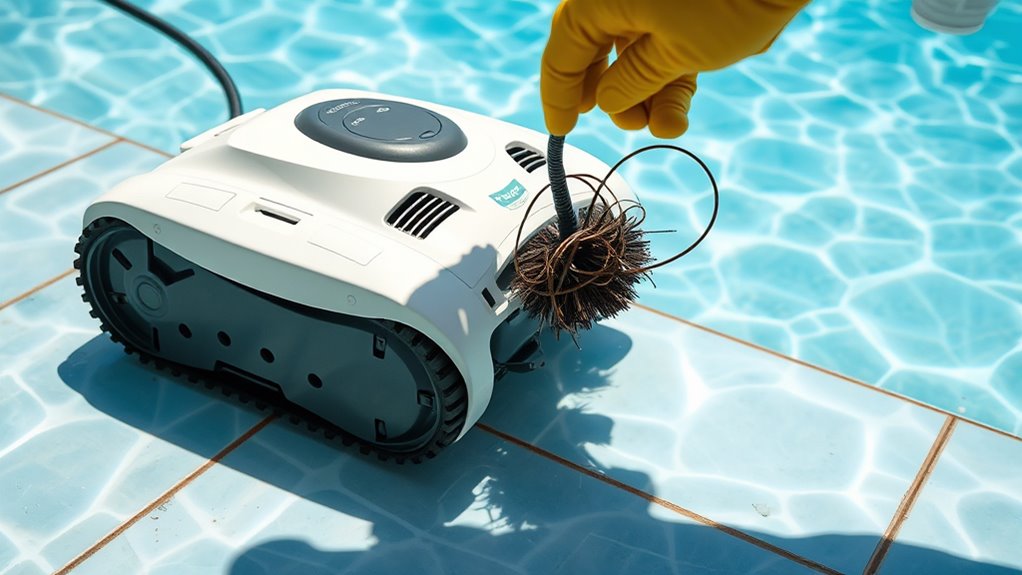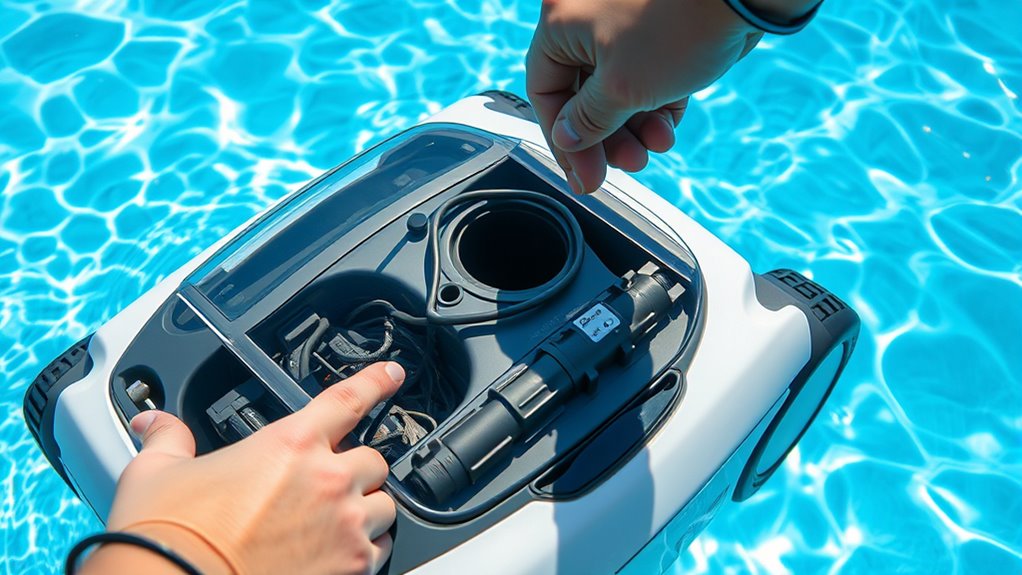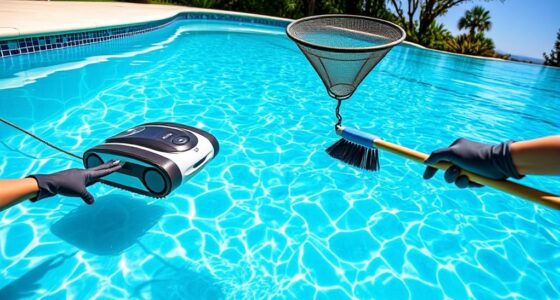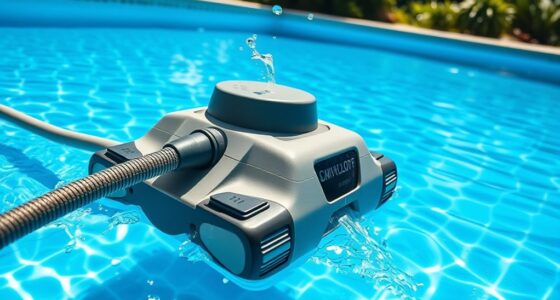If your robotic pool cleaner isn’t functioning properly, start by checking for navigation errors caused by obstacles or dirty sensors. Clean the sensors and clear debris from around the pool, especially near the ladder or floating toys. Inspect the power supply and cords for damage, ensuring the charger is properly connected and outlets aren’t tripped. Reset the device if needed, and update firmware for better performance. For more tips, keep exploring solutions to keep your cleaner running smoothly.
Key Takeaways
- Inspect and clean sensors regularly to prevent navigation errors caused by dirt or obstructions.
- Check power connections, cords, and outlets for damage or misalignment to resolve power supply issues.
- Remove debris and clear obstacles like ladder rails or toys to improve the cleaner’s movement and prevent getting stuck.
- Update firmware and perform system resets to address software glitches and enhance performance.
- Consult manufacturer troubleshooting guides or contact customer support for persistent or complex problems.

Are you experiencing trouble with your robotic pool cleaner not working properly? If so, you’re not alone. Many pool owners face issues that prevent their robotic cleaner from performing efficiently. The first thing to check is whether your device is experiencing navigation errors. Navigation errors happen when the cleaner struggles to map the pool or gets stuck in one spot, which can be frustrating and inefficient. These errors often stem from obstacles in the pool or a faulty sensor. Make sure your pool is free of large debris that could confuse the robot’s sensors, and inspect the sensors for dirt or damage. Sometimes, simply cleaning the sensors or removing obstacles can resolve navigation issues. Also, check if the robot’s path is blocked by ladder rails, floating toys, or pool walls, and clear these obstructions to help your cleaner move smoothly. If navigation errors persist despite these adjustments, consider resetting the device or updating its firmware if that option is available. Many modern robotic pool cleaners have software updates that improve navigation accuracy, so keeping it current can prevent future errors. Regular maintenance, like cleaning sensors and inspecting electrical connections, keeps your device in top shape. Additionally, understanding the sensor technology used in your cleaner can help you troubleshoot more effectively, as different models may have varying sensitivities and calibration needs.
Power supply problems are another common reason your robotic cleaner might not operate correctly. If your device isn’t turning on or keeps shutting off mid-clean, you should examine the power source. Start by checking the power cord and plug—make sure they’re securely connected and free of damage. Look for any signs of wear, fraying, or corrosion, and replace damaged cords immediately to prevent electrical issues. If your cleaner uses a charging base or station, ensure it’s plugged into a working outlet and that the station is positioned correctly, with no debris blocking the charging contacts. Sometimes, a simple reset of the power supply helps resolve these problems. Unplug the device, wait a few minutes, then reconnect and see if it powers up properly. If your pool’s electrical system has GFCI outlets, verify they haven’t tripped, as that could cut off power to your cleaner. In cases where the power supply seems fine but the robot still won’t charge or turn on, it might be a faulty power adapter or internal component, requiring professional repair or replacement. To prevent these issues, regularly perform routine checks on your electrical connections and ensure your power system is functioning correctly.
Addressing navigation errors and power supply problems early can save you time and money, and help your robotic pool cleaner work effectively. Regular maintenance, like cleaning sensors and inspecting electrical connections, keeps your device in top shape. If issues persist despite these efforts, consulting the manufacturer’s troubleshooting guide or contacting customer support can provide additional solutions. Remember, a well-maintained robotic cleaner will keep your pool sparkling with less hassle and more enjoyment.
Frequently Asked Questions
How Often Should I Perform Maintenance on My Robotic Pool Cleaner?
You should follow a regular maintenance schedule to keep your robotic pool cleaner running smoothly. Typically, you need to clean the filter and brushes weekly, especially during heavy use or after storms. Check the cleaning frequency based on your pool size and debris levels, and perform deeper maintenance monthly. Consistent upkeep ensures best performance and prolongs the lifespan of your cleaner, saving you time and effort in the long run.
Can I Leave My Robotic Pool Cleaner in the Pool Overnight?
You can leave your robotic pool cleaner in the pool overnight if it’s designed for continuous use, but it’s best to remove it occasionally to preserve battery life. When not in use, follow storage tips like rinsing and fully charging the device. This helps maintain peak battery performance and prevents damage. Always check your manufacturer’s recommendations to ensure your cleaner’s longevity and smooth operation.
What Should I Do if My Cleaner’s Brushes Wear Out Quickly?
If your cleaner’s brushes wear out quickly, you should start with regular brush replacement to keep your pool cleaner functioning at its best. To prevent excessive wear, make certain you’re not using the cleaner on rough surfaces or debris that can damage the brushes. Regularly inspect the brushes and replace them promptly when worn. Proper wear prevention techniques extend the lifespan of your brushes, saving you money and maintaining efficient cleaning performance.
How Do I Reset My Robotic Pool Cleaner to Factory Settings?
Ever wondered how to restore your robotic pool cleaner to its original settings? Performing a factory reset can often resolve minor glitches. To do this, follow the troubleshooting steps in your user manual—usually, you hold down a specific button for several seconds. This resets the device to factory settings, clearing any custom configurations. Remember, a factory reset is a simple yet effective way to troubleshoot and refresh your cleaner’s performance.
Is It Safe to Use My Robotic Cleaner in Chlorinated Water?
Using your robotic cleaner in chlorinated water is generally safe, but it’s important to ensure chlorinated water safety and the device’s durability. Most robotic pool cleaners are designed to withstand chlorinated environments, but high chlorine levels can affect their lifespan over time. To protect your investment, rinse your cleaner after use and follow manufacturer guidelines. Regular maintenance helps ensure your robotic cleaner remains effective and durable in chlorinated pools.
Conclusion
With a little patience and gentle guidance, your robotic pool cleaner can glide smoothly through your pool once again. Think of it as guiding a tiny boat across calm waters, restoring its rhythm and purpose. When you pay attention to its needs and give it a little care, it’ll return to dancing effortlessly beneath the surface. Soon, your pool will sparkle like a mirror, reflecting the sun’s warm embrace, inviting you to enjoy its pristine clarity.









